Arnold & Son HM Double Hemisphere Perpetual Moon: Perigee-Syzygy Of A Supermoon
I love looking at the night sky; it might be one of the most peaceful and mentally healing things a person can do (that and eating a large pizza).
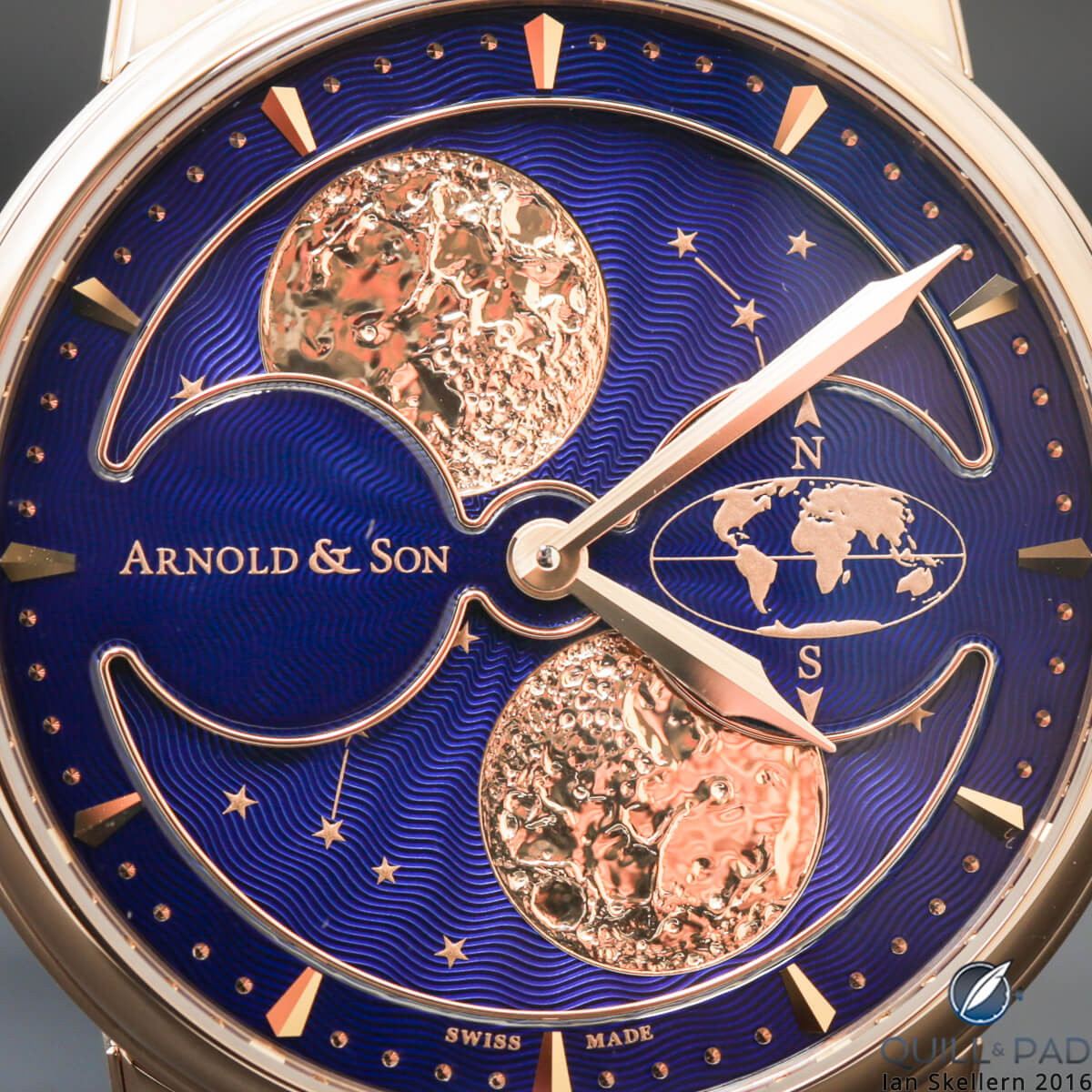
Arnold & Son HM Double Hemisphere Perpetual Moon
I just stare out into the universe and experience the vastness of it all. The expanse beyond earth is endless, but nearer to home we have a shining celebrity, one that has inspired countless minds through the ages: the moon. I’ve written about our nearest neighbor before, but recently we experienced the moon in a way that is extraordinary: the legendary supermoon.
Known in astronomical circles as the perigee-syzygy of the earth–moon–sun system, a supermoon results in the largest apparent size of the moon combined with a full (or new) moon. The reason the moon grows and shrinks in size is due to an elliptical orbit that varies the distance between the earth and the moon from 222,000 to 252,000 miles. When the moon is at perigee (closest point in orbit) during a full moon it appears almost 14 percent larger and 30 percent brighter than when it is farthest away at apogee.

A supermoon really isn’t as “super” as we may think (image courtesy Alec Jones)
This phenomenon is cyclical and occurs about every 411.8 days or 13.9443 synodic months, which results in a supermoon roughly every 14 full moons. Cycles this long create a mystique around events, and the supermoon is something that now makes the rounds on the internet as a super rare celestial occurrence.
Even if that is overstating things a bit, it still is something to be awed by. I know I spend as much time as possible looking up and making sure to catch a glimpse of every supermoon I can.
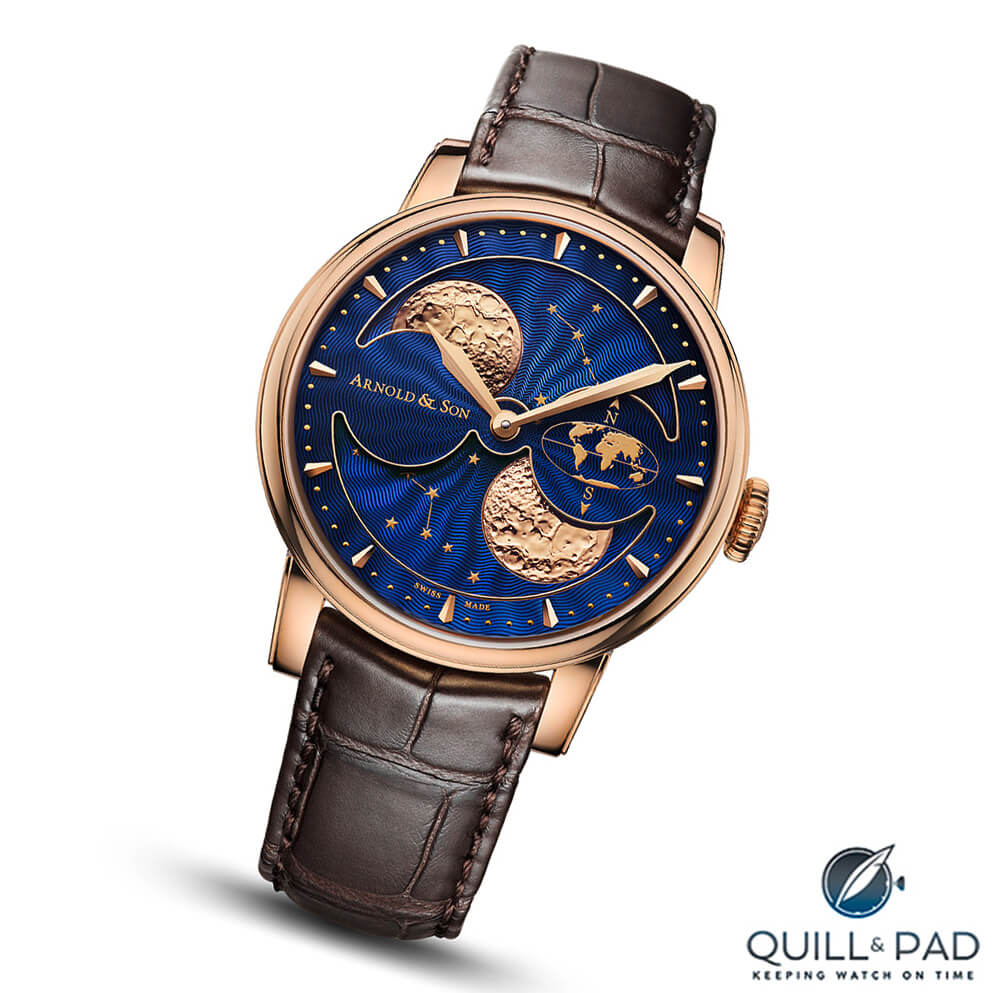
Arnold & Son HM Double Hemisphere Perpetual Moon
Yet, in between such amazing spectacles I am in search of other heavenly sights, usually finding solace in astronomical timepieces. Some of my favorites are moon phases, and an appropriately magnificent example is the Arnold & Son HM Double Hemisphere Perpetual Moon.
This watch is among the biggest and boldest moon phase watches in existence, and is one of my favorite pieces from Arnold & Son.
Origins of the Double Hemisphere Perpetual Moon
The HM Double Hemisphere Perpetual Moon is the child of the more “subdued” HM Perpetual Moon, which features an enormous 11.2 mm three-dimensional, hand-engraved moon surrounded by a guilloche dial. The original HM Perpetual Moon launched in 2013 and was an immediate success.
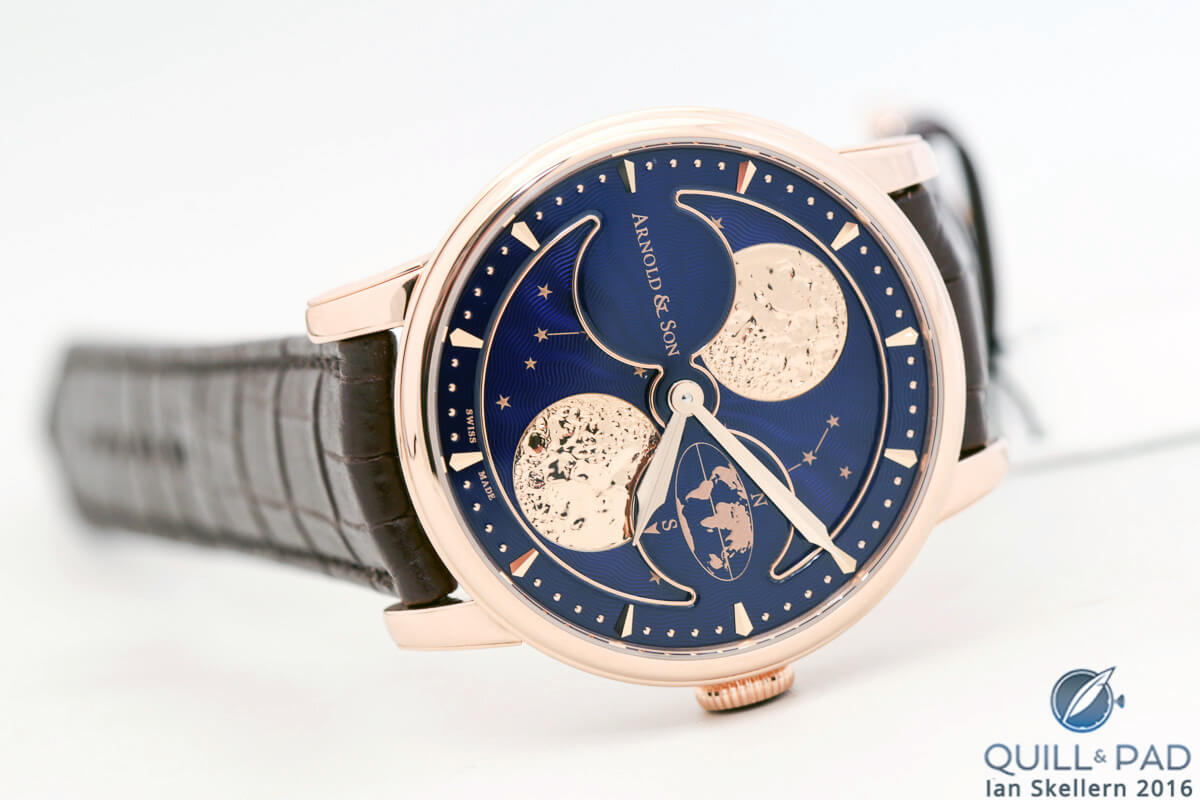
Arnold & Son HM Double Hemisphere Perpetual Moon
No other watchmakers were making anything as remotely breathtaking when it came to moon phases: this watch stood out like a shining ball of light in the night sky.
Given the popularity of the watch and its four variations, Arnold & Son knew it had a hit on its hands; it was really only a matter of time before it received a facelift.
The HM Double Hemisphere Perpetual Moon is, as the name suggests, twice the moon phase in the same package. There really is no secret to how it works, the massive 29 mm moon phase disk features two opposed moons that move through two window openings on the dial.
Launched at Baselworld 2016, the Double Hemisphere Perpetual Moon, became a fast favorite. It gave fans more of what they wanted: views of that beautiful golden moon.
Now, during a full moon, you are treated to more than 22 millimeters of moon magic with the top and bottom moons shining brightly. But what is the difference between the two moons, really?
For the answer you just need to stand on your head.
Don’t really stand on your head
The two moons represent the views of the moon from the northern and southern hemispheres, which see the moon differently based on the direction of viewing. People in the northern hemisphere (somewhat away from the equator) generally look down towards the moon as it orbits just about five degrees off the plane of the ecliptic, or almost in line with the earth’s orbit around the sun.
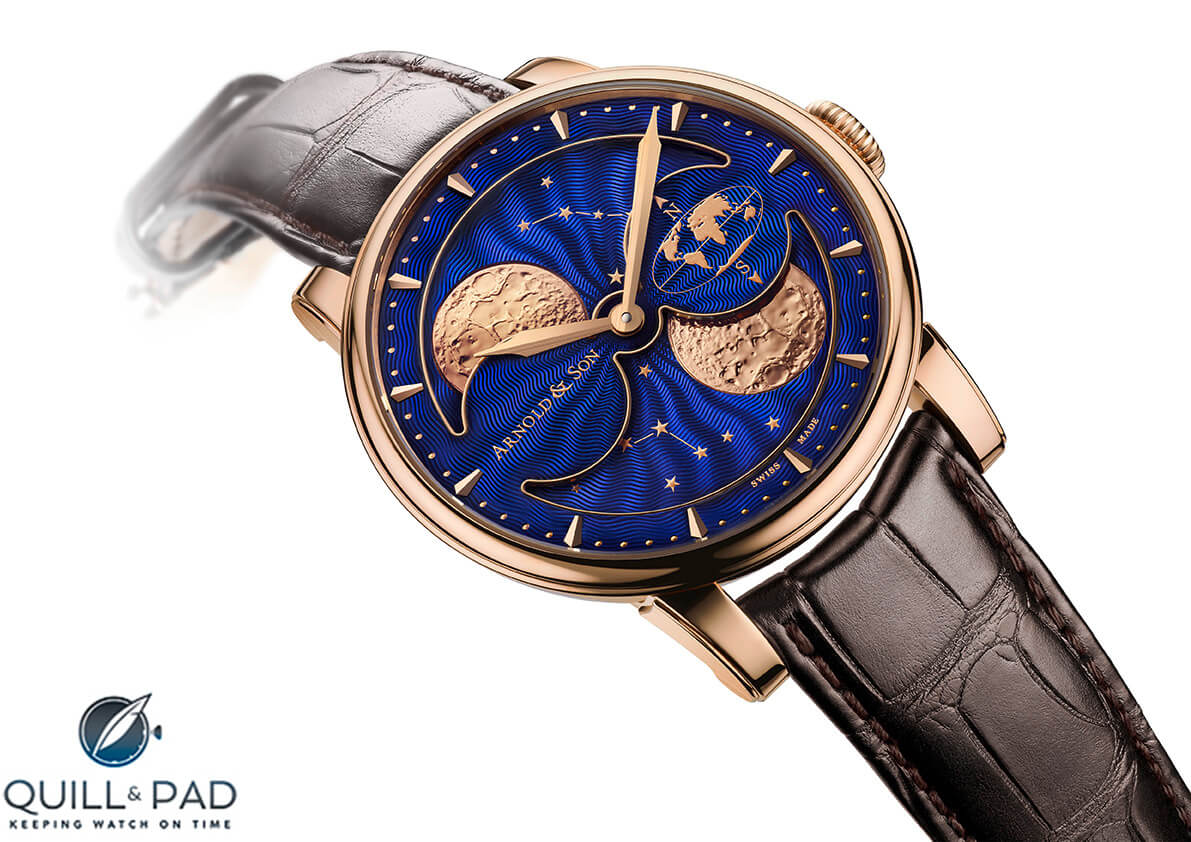
Arnold & Son HM Double Hemisphere Perpetual Moon
People in the southern hemisphere therefore end up looking up toward the north to view the moon.
That means that the area of the moon that becomes shaded during its waxing and waning cycles is mirrored between the northern and southern hemispheres. The simplest way to show this is to use a single disk with two mirrored moons on it as the Double Hemisphere Perpetual Moon does: two openings on opposite sides of the dial representing the views from the northern and southern hemispheres, allowing for the simple presentation of two moons moving across the sky in opposite directions.
This double display would be harder to present on a smaller scale and it would not be nearly as dramatic, so the HM Perpetual Moon provided the perfect impetus to create the Double Hemisphere Perpetual Moon.
And just in case the dual hemispheres aren’t as obvious as Arnold & Son hopes, a world map has been added between the two openings with an equator splitting the map into two hemispheres, with north and south arrows added for a bit of insurance. This way, no matter which side of the earth you live on you will always know what the moon looks like on the other side of the world (just in case that’s a concern).
More than meets the eye
But wait, there’s more for the moon-crazed horology nerds out there. On the rear of the movement is a third moon phase indication.
What?
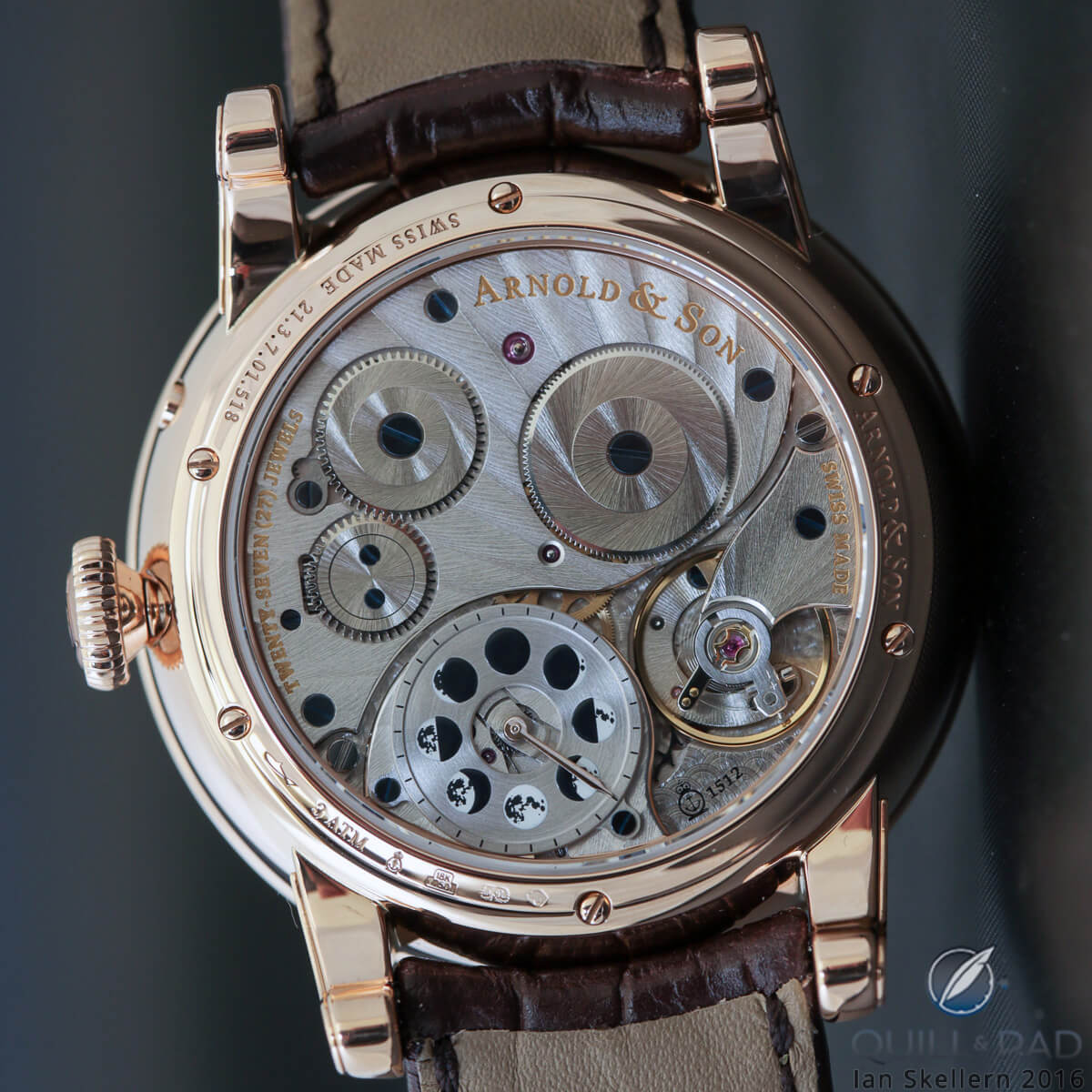
View through the display back of the Arnold & Son HM Double Hemisphere Perpetual Moon
Yup, except that this one is not really for keeping track of moon phases but for accurately setting the moon phase. The giant moons on the front will do a pretty good job for a 122 years but will then be one day off. To set the moon phase accurately, you use a small dial on the rear of the movement featuring eight mini moon phase images and 30 hash marks for easy adjusting.
Despite a lunar month measuring an average of 29.53 days, the brand divided it up into 30 segments. There is no easy way to divide a circle into 29.53 divisions, so I think that the idea was that 30 would be a nice round number.
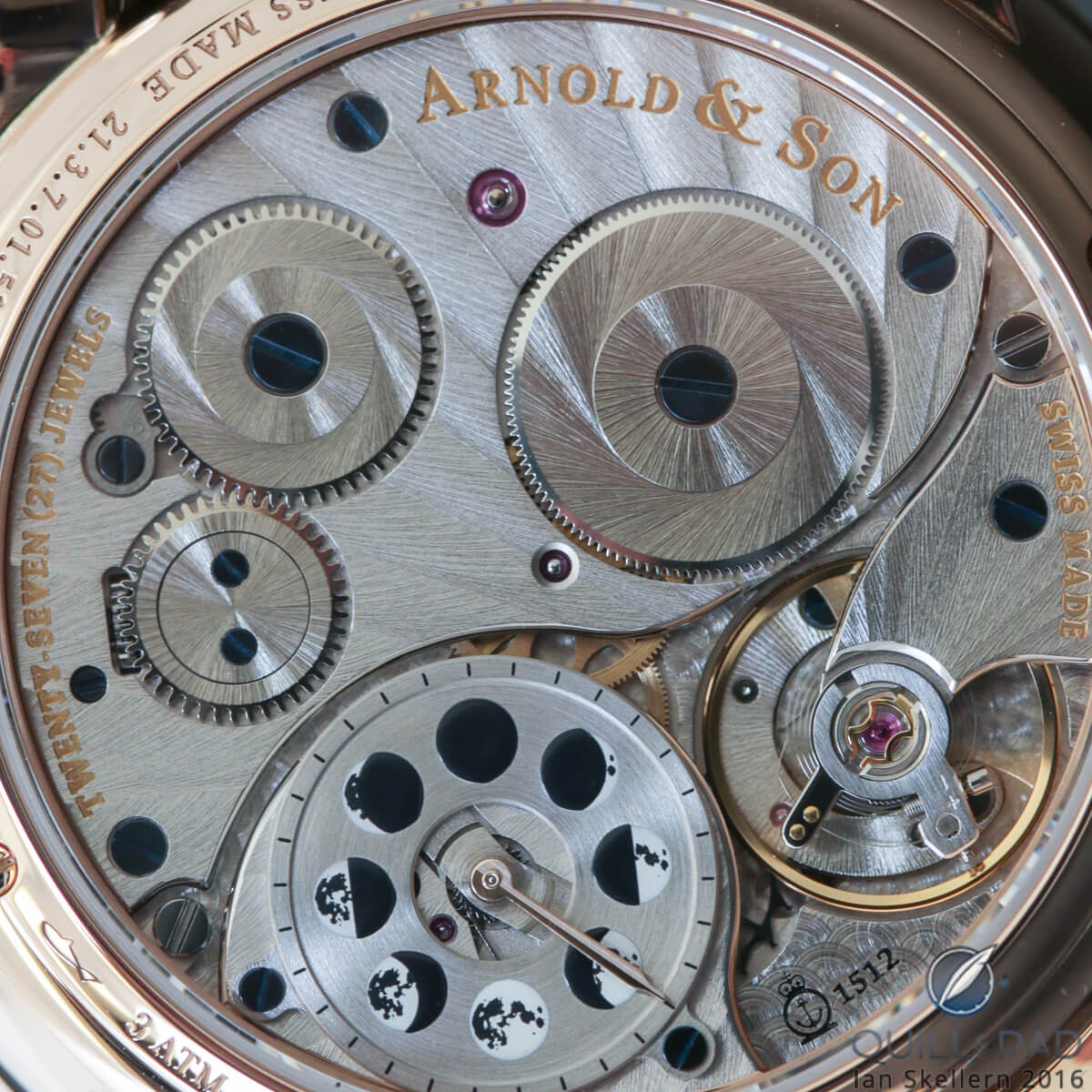
Movement of the Arnold & Son HM Double Hemisphere Perpetual Moon with the accurate moon setting disk st the bottom
This tertiary dial enables the user to set the moon phase relatively accurately at any time of day or night. I prefer to simply wait until the full moon (or the exact time of the full moon according to the internet or my Sarpaneva app) and set it then. But this will get you pretty darn close.
After setting it, you can enjoy the watch and the moons in all their glory.
The moons are based on an original hand-engraved master that was duplicated for the series via a mold and cast. This allows Arnold & Son to have the quality of hand-engraving, but with less time-consuming and more cost-effective production.

A close look at the dial of the Arnold & Son HM Double Hemisphere Perpetual Moon
But don’t fret, the dials and moon phase disks are all still hand-guilloche with a delicate sunray wave pattern coated in a striking cobalt blue. On top of the blue are golden stars and constellations as well as the applied indices for hours and minutes.
Style to spare
The look is kept rather minimal: not in the austere way Nomos keeps a watch clean, but in the way that a watch is maintained straightforward without excessive embellishments. The details are delicate and subdued, with the golden moons positioned as the true stars of the watch.
If I could make one change, were I to be in a position to purchase one, I might ask that the world map be left off, mainly because I know what I am looking at and it seems a bit out of place given the style. It helps to balance the dial a bit, but I don’t mind a little asymmetry considering the large lunar elements.
The case is classic Arnold & Son Royal Collection and it allows the dial details to shine and the watch to flow gracefully into the wrist. The grace continues around the rear as well. Being Arnold & Son, the sister company La Joux-Perret Caliber A&S1512 is a completely integrated movement with the moon phase built right in. As there is no added thickness of a separate moonphase module, this design allows the watch to remain as thin as possible, coming in at 5.35 mm.
The finishing on the movement is very nice as well, which is typical of Arnold & Son. The movement even comes with a 90-hour power reserve to make sure the moon phase stays as accurate as possible should you leave the watch on your nightstand over the weekend.
Many might say this is a special watch, but I also think this watch would be an incredible choice as a daily wearer. The earlier edition and its variations made this even more possible, and hopefully some similar color combinations will be available for the HM Double Hemisphere Perpetual Moon. I personally would love to wear this watch every day and track the phases of the moon in bold and beautiful gold around the dial.
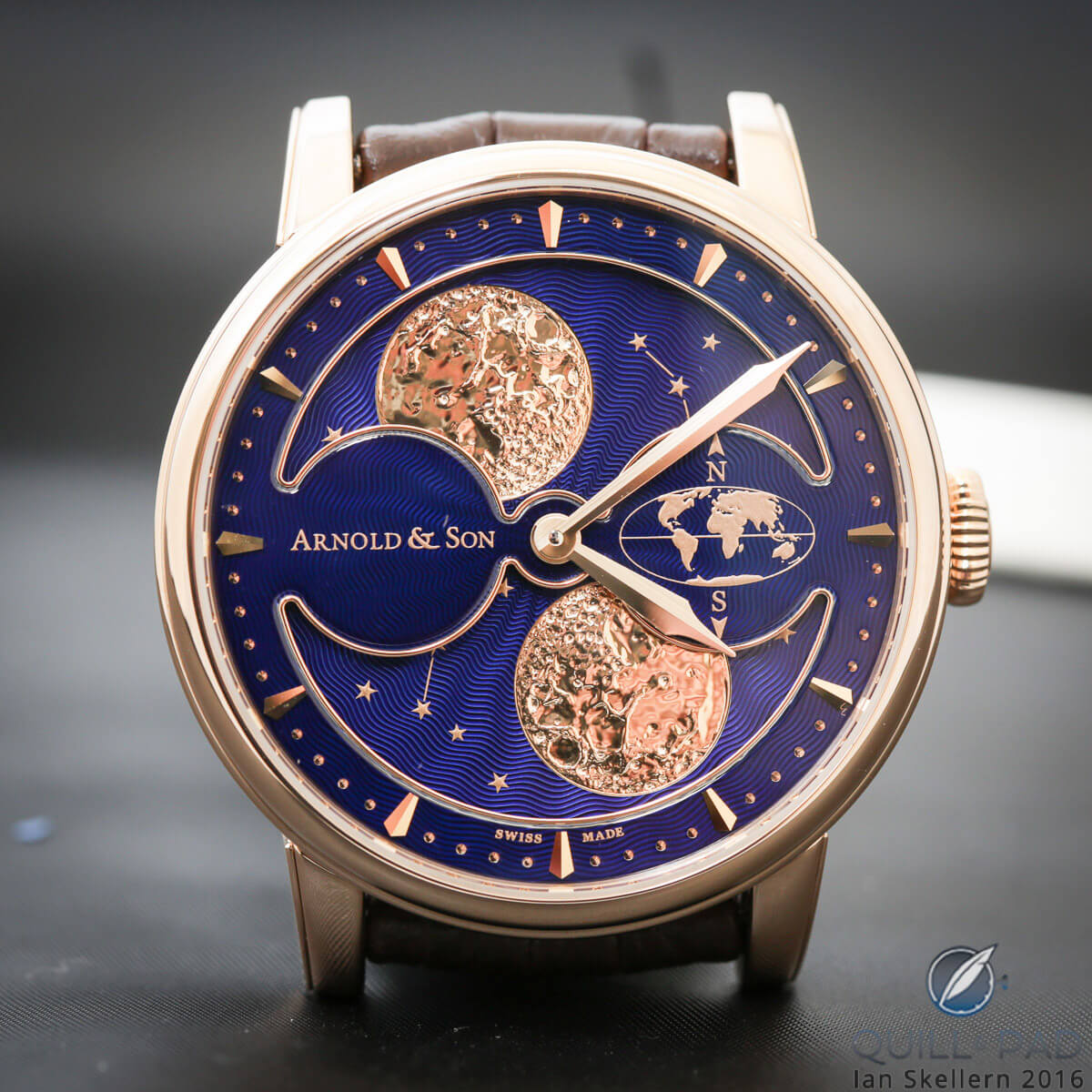
Arnold & Son HM Double Hemisphere Perpetual Moon
So until the next supermoon comes around – or perhaps a lunar eclipse or other celestial event – the Arnold & Son HM Double Hemisphere Perpetual Moon will work nicely to fill my astronomical inklings. And perhaps yours.
You owe it to yourself to gaze into those twin moons for a while, it might just help with your stress.
Or not, but how about a breakdown either way!?
- Wowza Factor * 8.8 Its predecessor wowed, and this one is a double wow! Two giant moons for your viewing pleasure: it gets all the wows in almost any crowd.
- Late Night Lust Appeal * 99.2 » 972.819 m/s2 Due to those magnificent moons and the awesome guilloche, this watch oozes lust appeal. I have spent many a late night gazing into those heavens!
- M.G.R. * 62.4 La Joux-Perret makes some very nice movements, and this one is no exception. It is rather tame compared to others from the workshop, but it still is an integrated moon phase movement with three moon phase displays.
- Added-Functionitis * Moderate This watch is not a time-only watch, and though it has three moon phase displays that only counts as one complication. Still, you will need some regular strength Gotta-HAVE-That cream heavenly horological swelling.
- Ouch Outline * 9.9 Carbon fiber sliver underneath your fingernail. The dangers of working with advanced composites include rather painful owies. But I’d gladly take another sliver for a chance to get this watch on my wrist for good!
- Mermaid Moment * Just look at those moons! I can’t imagine anyone taking one look at those magnificent moons and not falling head over heels. I know I’m ready to book the Plaza in March!
- Awesome Total * 778 Multiply the number of hours in the power reserve (90) to the total number of moons on the piece (10), and subtract the number of years before the moon phase will need adjusting (122) and the result is a very celestial awesome total!
For more information, please visit www.arnoldandson.com/hm-double-hemisphere-perpetual-moon/hm-double-hemisphere-perpetual-moon.
Quick Facts
Case: 42 mm, red gold
Movement: manual winding Caliber A&S1512 with 90 hours of power reserve from twin spring barrels
Functions: hours, minutes; three moon phase displays (one for the southern hemisphere)
Price: $31,000
Leave a Reply
Want to join the discussion?Feel free to contribute!



Lovely watch – though, being a Northerner, I prefer the single moon versions. Your Intro brought back a line from the old Dean Martin song (really!) :- ‘When the Moon hits your eye like a large pizza pie, that’s Amore!’
How about an article about the much more reasonably priced Schaumburg Double Mooon? http://www.schaumburgwatch.com/urbanic-double-moon.asp
Thanks for your suggestion! Quill & Pad generally focuses on the very highest end of watchmaking.